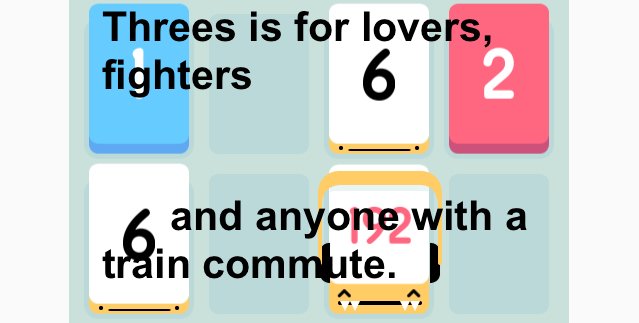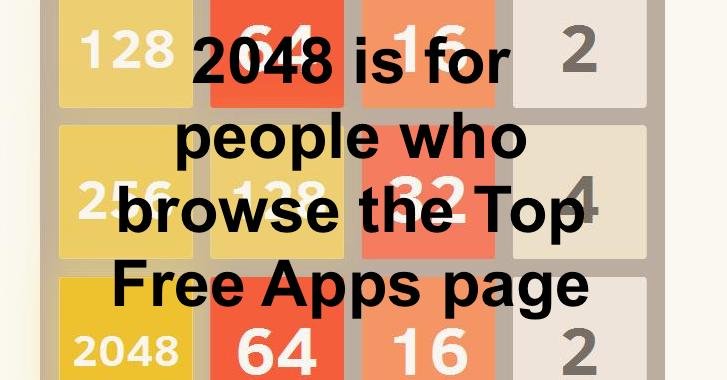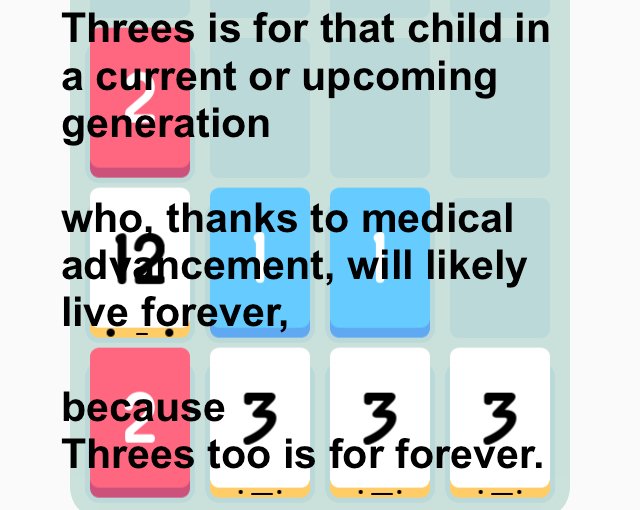
When my parents bought me a fat grey Game Boy in 1991, it came with Tetris (1984). I played a lot of Tetris then, and I’ve played a lot since. Tetris may be the platonic ideal of “video game,” insofar as something so absurdly subjective can be said at all. Safer at least, would be to say that Tetris is the platonic ideal of a “puzzle video game.”
Tetris like many good puzzle video games, could probably be played with scraps of paper on a table, except for one facet: You need the computer to randomize incoming tetrominoes. That you don’t have to manually make blocks fall at a regular rate or track your score are frosting on the cake.
Threes debuted on iOS in February 2014, 30 years after we got Tetris. Is it better than Tetris? What the hell. Sure.
What is Threes?
Threes (sometimes styled Threes! or THREES, both of which I’m into) is a puzzle game in which you combine like numbered tiles on a 4x4 grid, with new numbered tiles dropping in every turn. Each turn you are able to move the entire tile set one tile space in one of four cardinal directions. Don’t let the grid fill up, keep the tiles combining and get higher-numbered tiles! Threes is easier to play than to explain. It is simple to learn, infinitely harder to win, impossible to master.
Threes was developed by Sirvo, a team made up of Designer Asher Vollmer, Artist Greg Wohlwend and Composer Jimmy Hinson. You can find it on iOS, Windows and Android mobile devices, as well as the Xbox One for some reason.
Threes is for lovers, fighters and anyone with a train commute.
Threes is for one-handed gamers.
Threes is for that child in a current or upcoming generation who thanks to medical advancement will likely live forever, because Threes too is for forever.
Aesthetically, Threes is clean, smart and responsive. It runs at 60 frames per second. But it also lets you conserve your battery by dropping to 30 fps. One is smoother, but both are good peanut butter.
The color palette is bright and sharp. Tiles flit and perch like colorful birds. Higher-numbered tiles have tiny faces, tiny personalities. It’s like synesthesia realized in game form. If the brightness isn’t your toast and jam, you can switch to “night colors” - ideal for playing before bed if you want to turn the “Tetris Effect” into the “Threes Effect.”
The music is phenomenal, although if you’d rather turn on a podcast you can mute it; same for the sound effects.
Everything about Threes is approachable. A toddler can play it. Your grandpa can play it. The dev team is clearly proud of this. They love this game. They want you to love it. They’re all about the love. I feel loved just writing about Threes.

That being said…
There an elephant in the room. Let’s call it by name.
A lot of people have played Threes. A lot more people have played 2048.
Not to be confused with Sony’s PS Vita future-racer Wipeout 2048, 2048 (March 2014) is another tile-based mobile puzzle game with numbers. It was “designed” and created in a weekend, according to its developer, Gabriele Cirulli, who was 19 at the time. It launched for free on the app store and went as viral as a puzzle game can.
2048 plays similarly to Threes but not exactly like Threes. It’s source code is freely available. It has been cloned more closely than it has cloned Threes. It is neither a bad nor a great game, it is just not nearly as good a game as Threes.
2048 is for people who browse the Top Free Apps page - and I don’t mean this is as a pejorative.
When 2048 came out, about a month after Threes, the game dev community was understandably “icked”. And when 2048 began to steal Threes’ spotlight thanks to a $0 price tag, folks became irate, especially since the outside-games media didn’t seem to know how to cover what wasn’t exactly plagiarism but definitely a gross appropriation of style and substance.
Because 2048 isn’t exactly a clone of Threes. Here’s why:
-
Threes moves tiles one square at a time; 2048 moves them as far to the edge as they can go.
-
Threes hints at the next tile. Any tile above a blue 1 or salmon 2 is randomized from a set of three possibilities shown at the top of the screen. 2048’s next tile is always a 2. Always.
- Threes has no ads. 2048 runs banner ads at the foot of the screen. Threes is a paid app. $2. Have some integrity.
It’s not worth getting mad at 2048 in 2017. But it is worth glancing back at how it and Threes co-existed in the puzzle game marketplace. But the creators of Threes know their game is better. They’ve said as much, and more. 2048 is easier than Threes, which helps explain part of its appeal. You have to work to quickly lose a game of 2048 - most folks could play blind. And because there are a greater number of matching tiles (again, in 2048 all new tiles are 2s), there’s a great number of tile combos per minute. It gives the impression of progress. It keeps giving you the dopamine hits.
In 2015, Business Insider argued that 2048 is a “souped up” version of Threes in the same way crack is a “souped up” version of cocaine. “The former is no guide to the addictive power of the latter.” My personal distaste for the term “souped up” aside, this is asinine commentary. In reply, game designer Matt Rix put it best: 2048 is a "souped-up" version of Threes in the same way that a bag of chalk is a "souped-up" version of cocaine.
So there’s that elephant acknowledged and shoved from the room.

Now, the question remains: What makes Threes so good?
A note on incoming tiles
Let’s get momentarily technical. Above I noted that Threes is easy to learn, infinitely harder to win, and impossible to master. This last clause is key. You cannot master Threes because there are elements of randomization at play. One of the trickiest is that Threes randomizes not just what tile you get next, but where that new tile appears on the grid each turn.
There are rules here: The new tile must appear in a column or row where there is movement that turn. So if you swipe up to move your tiles up, the new tile will appear in the bottom row. If there’s only one open square on the bottom row, the new tile will appear in that square. If there are multiple open squares in the bottom row, the algorithm dictates that the new tile will appear in a randomized square in that bottom row.
So, does randomization make Threes a better or worse video game?
This is the real question.
Or perhaps, the real question is: Are puzzles with elements of randomization better than puzzles without?
Randomization is what the computer brings to puzzles. It goes beyond just putting the “video” in “video game.” You could grab some construction paper and create a beautiful bespoke version of Threes playable on any flat surface. But shuffle incoming tiles as you may, you’d arguably never get a truly random deal. (Mathletes, come at me.) The important thing is that the computer automates randomization. If it takes seven rounds of shuffling to mimic randomization in a 52 card deck, imagine the pain it’d be to play table Threes.
Whether or not you enjoy randomization in your puzzles, this is the part of Threes (or Tetris or Solitaire or Poker) that makes it a puzzlegame rather than just a puzzle. You cannot play a perfect game of Threes, only your most perfect game. I like this. It removes absolutes.
This is why Threes is subjectively the best game ever made.
Threes doesn’t appeal to the perfectionist in you. It also doesn’t pander to the perfectionist in you. I love Threes for this reason. It takes my philosophy of “games” and runs with it. You can “beat” Threes - someone did so just recently, over 3 years after its release - but you will never master it. Threes is your peer, it works with you, not for you or against you. Threes is your friend with whom you have a complicated but loving relationship. Threes isn’t just going to let you win.
And you will love it more for it. Threes is love. So, please, give Threes a chance. ★